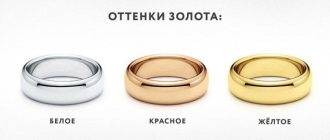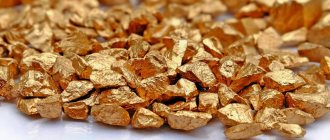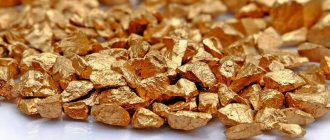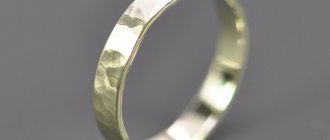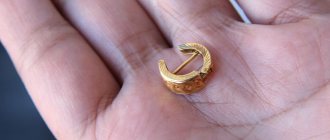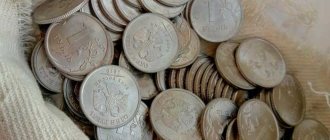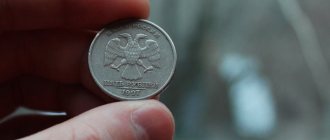You, no doubt, know that jewelry is almost never made of pure gold, since this metal very quickly becomes scratched and loses its beautiful appearance.
In addition, a product made from it can be easily bent with your fingers, and small parts break off and are lost at the slightest damage. To make gold stronger, a ligature is used - a special additive that improves not only the strength, but also the color of the jewelry. Let's talk about what a ligature is in jewelry, what it consists of, and how it changes the properties of gold.
What is a ligature?
Ligature is a word borrowed from Latin, where “ligatura” means “connection” . In metallurgy and jewelry, this is the name given to metals whose addition to the melt improves the properties of the original metal. Sometimes the additive is very small, but even a slight presence of the alloy can lead to a change in the characteristics of the alloy. By varying the composition and percentage of additives, it is possible to obtain alloys with the desired properties: stronger, fusible, forgeable, etc.
For jewelers, the appearance of the metal is important, so additives that can change the color of gold are of particular interest. Ligatures make it possible to obtain gold of almost any color, from silver-white to brown, green and even bluish. As a rule, jewelry alloy for gold consists of silver and copper in various proportions, to which palladium, platinum, nickel, cadmium and zinc can be added.
The ligature for silver is copper. Today, jewelers purchase almost all the necessary ligatures ready-made in the form of ingots. To prepare a gold alloy, simply measure the desired metals by weight and place them in a crucible to melt.
Braces to match your eye color
The ligatures in braces can be metal - made from medical steel, or rubber - made from hypoallergenic polyurethane. Metal ligatures fix the system more tightly and are more stable, but rubber ones are more popular, because they come in 24 different colors. You can choose ligatures of your favorite color, use several shades at once, and change them depending on your mood. This is especially true for children, who are usually embarrassed to wear braces. But colored ligatures on braces can significantly brighten up the process of correcting your bite. By the way, perhaps the child will be consoled by the fact that even the star of the Harry Potter films, Emma Watson, had to wear a metal structure at one time.
Sometimes a person accidentally swallows a braces ligature, and then the question arises whether this is dangerous to health. You can rest assured that modern rubber ligatures are made of medical polyurethane and will not become an obstacle to the digestive system.
Jewelry alloys
Pure gold and pure silver are very soft metals, but the alloy of these metals unexpectedly acquires a higher hardness than either of them alone. In addition, it is more ductile, has better malleability than parent metals, and melts at a lower temperature. Those. adding silver to gold improves its properties from a jewelry point of view. Copper and a number of other metals, called base metals, have a similar quality in relation to gold and silver.

The addition of a small amount of silver to gold makes the alloy pale yellow, but if you take gold and silver in equal parts, the yellowness completely disappears. An alloy of gold and copper, on the contrary, looks reddish: copper adds brightness to the noble metal. Therefore, for the jewelry industry, an alloy containing silver and copper is used to obtain a beautiful noble gold hue and high hardness of gold.
Often gold deposits are mined already fused with silver. Such a native alloy containing 45% gold is called electrum. At gold mining enterprises, metals are separated in order to then create various alloys with precisely taken proportions and pre-known properties.
Meaning of the word ligature
Ligature is a sign of any writing system or phonetic transcription, formed by combining two or more graphemes, for example: Danish. , ex. , nor. , Osset. æ; German ß.
You can usually see by looking at the unfused parts which letters are part of the ligature. In some writing systems, ligatures of many letter combinations have come into general use, being, as it were, complex letter signs for depicting certain sound complexes.
Ligatures were widely used in the Middle Ages as a way to speed up writing and save space. Ligatures appeared in manual typesetting immediately with its invention, when the German pioneer Johannes Gutenberg, in order to achieve line evenness and similarity to handwriting, used ligatures and various variations of the same characters in his 42-line Bible. Later, ligatures were used in book printing, for example, to reproduce consecutive Latin characters f and i with the same aproses as between other letters, the sign fi was used, since the use of ordinary letters was impossible. This method was used for quite a long time in manual typesetting, but practically disappeared with the advent of Linotype and Monotype, since there were not enough places for ligatures in their matrices. For the same reasons, ligatures were absent in the first digital fonts, due to the limitation of the number of glyphs to 256, and if they were inserted into the set, it was either manually or hardware in a layout program. They began to be actively used with the advent of OpenType format fonts, where the number of possible glyphs expanded to 64 thousand, and various kinds of replacements can be written in any programming language.
At the same time, ligatures were often used to decorate and ornamentalize texts, for example, in ligature.
Nowadays, many ligatures can only be found in historical sources (for example, in the authentic reprint of “The Lay of Igor’s Campaign”) or in those languages where they actually acquired the status of independent letters (French, Norwegian, Dutch, Armenian and many others).
In Arabic writing, the ligature Lam-alif is used. Script types with numerous ligatures include the Indian Devanagari script and the angular (Croatian) Glagolitic script.
In Chinese, phrases combined into one character are used as ligatures.
Some ligatures have actually become logograms, such as the ampersand (&, of) used in many European languages to mean the conjunction "and", regardless of the actual pronunciation of the word.
Less commonly, ligatures are called digraphs, trigraphs and tetragraphs, that is, the designation of one phoneme by two, three or four graphemes, for example,,.
If a ligature is used for a long time, its evolution continues. In particular, it is possible for a ligature to transform into a special character. Such signs include the symbol “ ”, presumably formed from the English preposition “at”.
A little theory
Sample is an indicator indicating the numerical ratio of pure noble metal to additional impurities in a specified unit of weight.

For example: the well-known 585 standard gold says that in 1000 conventional units of metal there are 585 units (or 58.5%) of pure gold of 999.9 standard, and everything else is auxiliary components.
Which? But this is exactly the question that the ligature indicator answers.
Ligatura means “connection” in Latin. The ligature will tell you exactly what additional metals are in the alloy with noble gold or royal platinum.
Please note that a letter is placed next to the hallmark, for example C. This letter means the city in which the assay office that issued this hallmark is located.
More about self-ligating systems
This design option is newer and allows you to reduce the duration of malocclusion correction. Due to the free sliding of the arc in the plates, sufficient, but not excessive pressure is created, which contributes to the gradual alignment of the teeth with minimal discomfort for the patient. The key characteristics of self-ligating devices are discussed in more detail below.
Advantages and disadvantages of the model
Self-ligating braces have many undeniable advantages. This is a newer and more advanced option for orthodontic treatment, which is characterized by the following advantages;
- You need to visit a specialist once every 1.5-2 months,
- the friction force of the arc in the grooves of the plates is minimal, which allows reducing the duration of the course,
- the absence of rubber bands and additional metal parts greatly facilitates the care of the oral cavity and, accordingly, the structure,
- most often it is possible to avoid preliminary extraction of healthy teeth even in complex clinical cases,
- the compact dimensions of the plates and the device itself significantly facilitate and speed up the adaptation period,
- fixation of the system is allowed even in case of periodontal tissue diseases1 due to weaker pressure,
- such braces look more aesthetically pleasing than bulky ligature structures,
- They are easily and quickly installed, just as they are removed, which minimizes the risk of injury to the enamel.
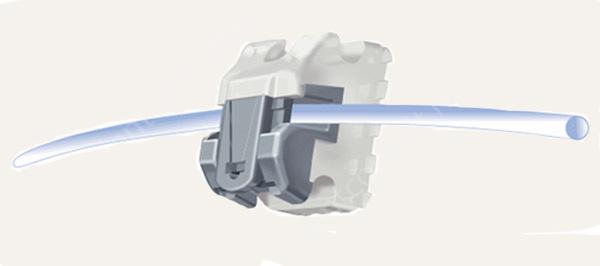
The disadvantages include the rather high cost of treatment. In this case, the high cost is largely due to the complexity of the design itself and its production.
Features of the adaptation period
Thanks to the free sliding of the archwire in the grooves, the teeth do not experience excessive pressure, since they do not have to withstand high frictional forces. This feature greatly facilitates the adaptation period for patients, because the painful sensations at first are not as pronounced as in the case of the ligature system. However, patients still note some inconveniences at first, mainly associated with problematic chewing of food and impaired diction. In general, adaptation to a fixed device takes only a few days.
Types of systems without ligatures
Self-ligating braces are made from metal and aesthetic materials such as artificial sapphire and ceramic. They are practically invisible against the background of the enamel, but they are characterized by increased fragility and require much more time to correct existing defects. Metal devices in this sense are more reliable and efficient. There is also the option of combining different materials, for example, ceramics can be placed on the upper teeth, which fall into the smile zone, and for the lower jaw, you can choose traditional metal plates, which will give the desired effect much faster.
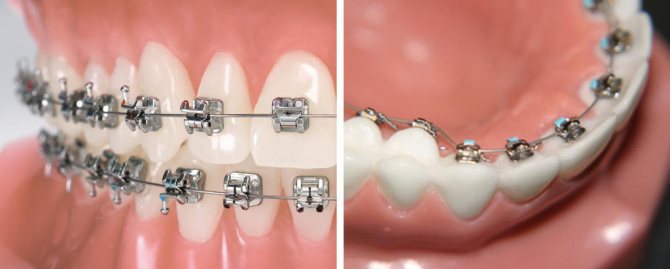
In the photo on the left are vestibular braces, and on the right are lingual braces
Ligature-free braces are mainly only vestibular, lingual - much less often, due to the peculiarity of their location - on the inside of the teeth. Despite the logic of manufacturing such self-ligating systems, manufacturers still at this stage give preference to ligature fastening, because on these models it is smaller in size and more efficient in terms of controlling the device.
More about ligature braces
This is a classic design used to correct malocclusions and correct incorrect position of teeth. Sometimes only this type of device can provide guaranteed elimination of serious anomalies. Let's take a closer look at the key characteristics.
What are the pros and cons
Among the undeniable advantages of traditional braces there are many important points. Here are the main advantages, which often become the deciding factor when choosing the type of structure:
- the ability to correct even very complex and serious anomalies that no other options for fixed systems can cope with,
- guaranteed treatment effectiveness,
- the most affordable price when it comes to metal models,
- the ability to fix bright multi-colored elastic bands - they look very original, which attracts the attention of children and adolescents to the treatment.
Among the disadvantages, it is worth highlighting the frequent, in fact monthly, visits to a specialist to update the ligatures - if we are talking about elastic bands and not wire fastenings. Treatment lasts a little longer than with non-ligature devices. In this case, the arch is fixed motionless, which often leads to quite acute pain, especially during the adaptation period. It should also be taken into account that rubber bands can change color under the influence of coloring pigments. The design is quite cumbersome, caring for it can be fraught with certain difficulties - food will clog in large quantities.
Features of the adaptation period
According to experts in the field of orthodontics, it takes about a month on average to get used to the device. However, everything here is purely individual: some patients quickly get used to it, while others need a little more time. During the first time after installation, many people note a pronounced nagging pain that goes away after a couple of days. To alleviate the condition, you can take a pharmaceutical painkiller. Other problems that inevitably arise include difficulties with eating and some problems with diction. To prevent protruding parts of braces from rubbing and scratching the mucous membrane less, experts strongly recommend using special wax.
What types of ligatures are there?
As we already know, the plates of ligature systems are created from various materials. However, the ligatures themselves can be presented in one of two variations:
- elastic - elastic bands in the shape of rings that connect the arch with the staples. They stretch quickly and therefore require frequent replacement,
- metal - thin wire is also designed to connect the arc with staples. Due to this, the structure is much more rigid, so it is not installed in the first stages of treatment.
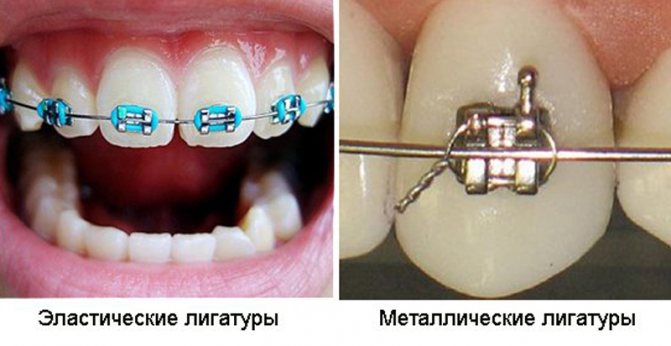
An orthodontist will help you choose a suitable option, based on the results of the examination and x-ray examination.
